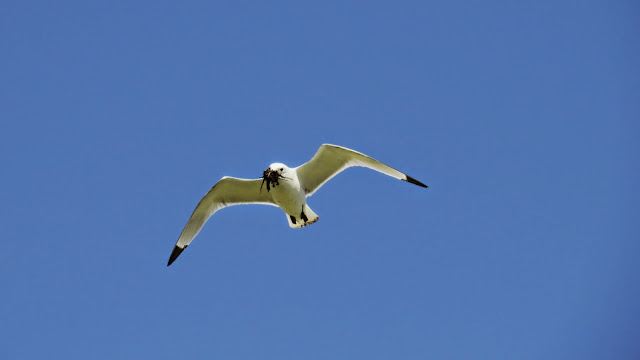Skomer
The Puffin. Such personality. Sitting low on a wooden bench overlooking a sheer cliff face where the cacophony of boisterous seabirds echoed through the ravine. Kittiwake, mouths full of claggy mud extracted from a nearby pond flew low overhead onto their negligible area of rocky scree, a ledge where home would be, where broods would reach maturity, where fledglings would make their first nerve jangling flights, where the future of our seabirds endure.
Kittiwake
Guillemot and Razorbill, in their communal huddles, co-existing is such dramatic and harsh surroundings, cliff dwellers that defy logic, gravity, and social sensibilities. No magic, just nature.
Razorbill
Fulmar too, a little more savvy with their nesting choices, opting for a spacious penthouse, majestic fliers, but raucous neighbours. Raven choosing real estate wisely too, tucked away in the cavities, early nesters with mature young.
The Puffin though is just a magical creature. There are approximately 22,000 of these enigmatic Auks on Skomer. Watching the birds fly in, extremely wary, syncopated head movements, then that comical waddle toward their burrows. A bill in pure technicolour contrasting pale cheeks, the delicate facial patterns, that red-orbital eye ring, the yellow 'petal' at the join of the mandible, you just couldn't drag yourself away from them. The whiskey only heightened the senses.
The camera shutter clicks, but it does nothing to capture the personality, sound, and pure comedy.
The trip started in Cardiff, meeting with great friends, it wasn't long before the Ale and Whiskey were flowing. It just led to a tardy start the next morning, up early, and on the road in atrocious weather conditions.
Arriving at 'port' it was cool, but the rain had gratefully ceased. Jumping onto a small vessel we sailed round the rugged coast, a precursor to the sights and sounds to be experienced on our one night stay on Skomer. A single Shag loitered on the choppy waters, as did a few Gannet, but the number of Auks were increasing as we approached the island. Arrow like flight, avian missiles circling the boat. Guillemot, Razorbill, Puffin, all increasing in number.
Alighting on the island, our bags were transported onto a farm tractor to the lodgings while we made our way on foot through the centre of the island. Our first male Northern Wheatear seen, one of many to be observed and one of around fifteen breeding pairs across the island.
Northern Wheatear
At the Farm House, we settled in and prepared ourselves for the day. The skies had cleared and the sun was out, appreciating the times when things go in your favour. We also set ourselves a target, fifty species in a day. Manageable we thought, plenty to see. Heading toward the north side, a male Stonechat sat atop the scrub, while Sedge Warbler sang within it. There were plenty of Common Whitethroat around too.
We headed onto the top of the cliffs, the sweet charrr of Red-Billed Chough flew past, four in total, wings folded in before floating round the cliff face, how beautiful a 'black bird' can be.
In the distance, Grassholm Island was visible, inhabiting one of the largest Gannet colonies in the world, 40,000 pairs. The Island was completely white on one side. Not guano, just birds.
Heading round the island, the views were stunning, around the rocky headlands and out to sea. The sun became more milky during the day, it felt like a thin canopy had been lowered, and nature was just for us to appreciate.
There was also a target. Fifty. A nice round number and it was close. Three drake Shoveler were seen on various ponds, and a sole White-Fronted Goose looked a little forlorn on the North Pond. Most likely a wild bird. Hirundine movement was apparently the best it had been this year with Swallow, House Martin, and Sand Martin all moving through in good numbers. Small groups of Common Swift were the first to be seen on the island this year. A female Peregine flew purposefully from one of the small islands.
Even female Mallard, female Blackbird, Moorhen, and Feral Pigeon, heralded micro-celebrations. Maybe we were a little too fixated on this. At least four Spotted Flycatcher were seen close to the farmhouse, a mini-arrival perhaps due to the weather. A single Whimbrel flew east as we headed back to the farmhouse.
The evening closed in. We drew a blank on both Little and Short-Eared Owl, but dining on a cheap packet pasta dinner overlooking the island in the low light was hardly a reason for consolation.
Then the night-time came, a bit more whiskey, warm clothing, and a torch. Heading out into the darkness, the eerie sounds of sea-faring Manx Shearwater returning from their pelagic retreat echoed all around. Dark shapes flashing past. By torch-light, these immense agile fliers hit land, their ineptitude for ground movement awkwardly exposed allowing close views of a bird usually observed out to sea at distance. With an estimated 300,000 breeding birds on the island, this represents the largest Manx Shearwater colony in the world. Such a privilege to be in such close proximity to them.
Manx Shearwater
At least two Harbour Porpoise were seen by the boat on our way back to the mainland.
We hit our fifty target - hardly a thing - but what a treat to have spent time here. A natural experience that should not be missed. Each to their own I guess, but I personally wouldn't have it any other way.























"The whiskey only heightened the sense". embarrassingly heightened the sense would be better phrased!
ReplyDeleteHa - I thought talking to the Puffin was a perfectly normal thing to do...
ReplyDelete